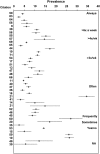Epidemiology of pediatric obstructive sleep apnea
- PMID: 18250218
- PMCID: PMC2645255
- DOI: 10.1513/pats.200708-135MG
Epidemiology of pediatric obstructive sleep apnea
Abstract
Pediatric obstructive sleep apnea (OSA) has become widely recognized only in the last few decades as a likely cause of significant morbidity among children. Many of the clinical characteristics of pediatric OSA, and the determinants of its epidemiology, differ from those of adult OSA. We systematically reviewed studies on the epidemiology of conditions considered part of a pediatric sleep-disordered breathing (SDB) continuum, ranging from primary snoring to OSA. We highlight a number of methodologic challenges, including widely variable methodologies for collection of questionnaire data about symptomatology, definitions of habitual snoring, criteria for advancing to further diagnostic testing, and objective diagnostic criteria for SDB or OSA. In the face of these limitations, estimated population prevalences are as follows: parent-reported "always" snoring, 1.5 to 6%; parent-reported apneic events during sleep, 0.2 to 4%; SDB by varying constellations of parent-reported symptoms on questionnaire, 4 to 11%; OSA diagnosed by varying criteria on diagnostic studies, 1 to 4%. Overall prevalence of parent-reported snoring by any definition in meta-analysis was 7.45% (95% confidence interval, 5.75-9.61). A reasonable preponderance of evidence now suggests that SDB is more common among boys than girls, and among children who are heavier than others, with emerging data to suggest a higher prevalence among African Americans. Less convincing data exist to prove differences in prevalence based on age. We conclude by outlining specific future research needs in the epidemiology of pediatric SDB.
Figures
References
-
- American Heritage Dictionary. 4th ed. Boston: Houghton Mifflin; 2001.
-
- Strollo PJ, Sanderes MH. Significance and treatment of nonapneic snoring. Sleep 1993;16:403–408. - PubMed
-
- Pediatric Pulmonology Subcommittee on Obstructive Sleep Apnea Syndrome, American Academy of Pediatrics. Clinical practice guideline: diagnosis and management of childhood obstructive sleep apnea syndrome. Pediatrics 2002;109:704–712. - PubMed
-
- Guilleminault C, Winkle R, Korobkin R, Simmons B. Children and nocturnal snoring–evaluation of the effects of sleep related respiratory resistive load and daytime functioning. Eur J Pediatr 1982;139:165–171. - PubMed
-
- American Thoracic Society. Standards and indications for cardiopulmonary sleep studies in children. Am J Respir Crit Care Med 1996;153:866–878. - PubMed
Publication types
MeSH terms
Grants and funding
LinkOut - more resources
Full Text Sources
Medical

